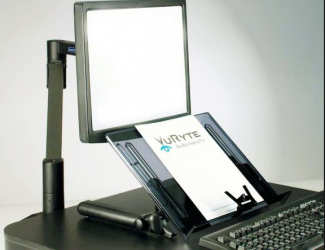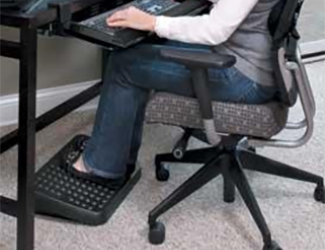Ergonomics
Ergonomics is the scientific study of human work and considers the capabilities and limits of the worker during interaction with tools, equipment, work methods, tasks, and the working environment. It is, “fitting the task to the person and not the person to the task”.
Wellesley College recognizes the importance of proper work environments and the prevention of cumulative trauma disorders (CTDs) as part of its overall safety effort. Promoting faculty, staff and student well-being is an essential part of maintaining an effective environmental health and safety program.
Responsibilities
Office of Environmental Health and Safety (EH&S)
The Office of EH&S shall maintain the ergonomics program to meet in-house needs and comply with applicable regulations and standards as well as:
- Conduct ergonomic evaluations for individuals as appropriate;
- Train employees and supervisors in ergonomic concepts.
Department Managers
Each supervisor/manager is ultimately responsible for providing a safe work environment for their employees. Each department will be responsible for funding and providing appropriate ergonomic supplies and equipment for their employees.
Employees
It is the individual’s responsibility to follow recognized practices and information provided. Employees should alert their supervisor/manager any potential ergonomic problems associated with the work area.
Human Resources
Administer the workers compensation program. Employees should fill out the Accident Report Form if injured at work. Completed forms should be send to HR and EHS within 24 hours of injury.
Accessibility and Disability Resources
Available to assist the campus community in providing information and assistance. Learn about the accomodation request process.
Medical Professionals
Medical professionals are available to conduct to evaluate employees who may suffer from injuries and illnesses. Please fill out the Accident Report Form and send to HR and EHS.
Workstation Design
The National Institutes of Occupational Safety and Health (NIOSH) recommends the following workstation design features:
- viewing distance to monitor should be 16 - 27 inches
- viewing angle of the monitor should be 15 - 35 degrees
- keyboard height of 28 - 30 inches
- adjustable chair with lumbar support.
Screen Height
The top of the display screen of your monitor should be at your eye level but not higher. For individuals who wear bi-focals, you may want the screen to be lower and closer. It is important to avoid awkward neck postures when viewing the screen or hard copy documents (that you may be working from).
Keyboard and Mouse Height
The height of the keyboard and mouse should be at the same level (i.e., you should not be reaching for your mouse). The right “level” is one where you can sit with your shoulders relaxed, elbows bent (around 900), and forearms, wrists, and hands parallel to the floor. The keyboard should be at an angle that helps you maintain a “neutral” or flat position of your wrists (i.e., your wrists should not be bending up or down).
Posture Support
Chairs should support the lower back region and help in avoiding pressure on the back and thighs (i.e., chairs should promote a comfortable posture). Your feet should rest firmly on the floor (or a foot rest if necessary).
Chairs
Employees sitting in chairs, especially all day, should have a comfortable fitting well-designed chair. The following features should be available:
- Pneumatic adjustments
- Seat adjustable with a tilt and depth slider.
- Backrest separate from seat, is ajdustable, can tilt & lock, and has lumbar support.
- Arms adjustable - height and lateral movement
- Various sizes - can have optional lengths, wider seats, tall backs.
Illumination/Glare
- Lighting levels in work areas will be set at the recommended levels for the specific equipment/function.
- Screen hoods and anti-glare filters can be installed upon request but it is important to reposition your monitor as a first step, when feasible, to help alleviate glare problems. For example, monitors should not be positioned in front of windows.
Work-Rest Regimens
- Take frequent breaks, get up and stretch, do not remain at the computer station for long periods of time, allow for rest.
- If you can, alternate tasks so that you are not conducting repetitive tasks (e.g., sorting or filing or typing, etc.) for prolonged periods of time. It is important to try to alternate between the various tasks to help prevent fatigue or discomfort.
Back Safety
Back disorders are listed in the "top ten" leading workplace injuries published by the National Institute of Occupational Safety and Health. They account for 27 percent of all nonfatal injuries and illnesses involving days away from work.
According to recent injury figures from the Bureau of Labor Statistics, each year there are over 880,000 cases of back injuries. In most sectors of industry, back injuries now rank either second or third overall (Bureau of Labor Statistics, 1998).
Over our lifetimes, 8 out of 10 people will experience a back injury and back pain. Most back injuries are painful, debilitating, and life changing.
What can Cause Back Pain
- Improper lifting technique
- Picking up oversize loads
- Using back belts improperly
- Posture and poor alignment
- Awkward stretches while reaching
- Being in poor physical condition
- Static work postures
Prevention
Preventing a back injury is much easier than repairing one. Because your back is critically important to your ability to walk, sit, stand, and run, it's important to take care of it, so here are a few basic rules:
- Exercise to strengthen your back and reduce stress
- Lose excess weight
- Maintain good posture – all the time!
Some Tips
Before you lift that box, or tool, or piece of equipment, take a moment to consider your action:
- Do you need to lift the item manually?
- How heavy is it?
- Is it packed correctly?
- Is it easy to reach the load?
- Where are you moving the item from?
- Where does it have to go?
- What route do you have to follow?
When Lifting:
- Keep feet parted for stability
- Squat down bending at the knees (not your waist). Tuck your chin while keeping your back as vertical as possible.
- Get a firm grasp of the object before beginning the lift.
- Begin slowly lifting with your LEGS by straightening them. Never twist your body during this step.
- Once the lift is complete, keep the object as close to the body as possible
- Pace yourself and get help before you try to lift a heavy load.
- Use mechanical lifting devices to lift and or move heavy objects. If using a forklift or similar type device, make sure you have the appropriate training.
- Slide heavy materials if possible rather than lifting them. Planks and rollers can make this job easier.
- Storing materials at least 12 inches off the ground, can minimize having to lift directly off the ground.
- Never try to catch heavy falling objects.
Ergo Evaluations
If you are symptomatic and need help in addressing your work station ergonomic concerns please have your supervisor/manager fill out this form and either email or send interoffice to Suzanne Howard in the EH&S Office. EH&S will then schedule an assessment of your current work station.
An office evaluation will look at the chair, how/where you place your feet, the desk, keyboard tray and keyboard, the mouse, monitor, lighting, telephone use, and behaviors while working. Remember to take breaks, stand-up and stretch!
Suggested stretches/workout from Self Magazine
Ergonomic Equipment
Check the Purchasing Web Site for Vendor Info.
- Chairs: What to look for when obtaining a new chair:
- Five casters
- Adjustable seat, height and back
- Adjustable arm rests or no arm rests
- Manual provided
- Durable construction
- Comfortable fit for your body
- Lumbar Support
- Seat Pan can tilt
- Chair can swivel
- Pneumatic Controls
- Good Warranty!
- Document Holder
- Footrest
- Headsets
- Height Adjustable Desks/Standing Desks
- Keyboad and Mouse Trays
- Mice
- Monitor Arms
- Task Lighting





Resources
- OSHA Web Site - Ergonomics
- UCLA - Ergonomics Web Page - Groundskeepers, Dining Staff, Labs, etc.
- Yale University - Ergonomics Web Page - Library Staff, Maintenance, Custodial and more
- Cal/OSHA - Publications on Ergonomics for Office setting and Construction Industry
- Oregon - Occupational Safety and Health - Ergonomics
- Washington State - Department of Labor & Industries - Ergonomic Evaluation Tools
- Microsoft Support - Keyboard Shortcuts for Windows
- Video from SAIF - Office Ergonomics - Simple Solutions for Office Safety
- CDC/NIOSH - Ergonomics and Musculoskeletal Disorders
Contact EHS at x3882
